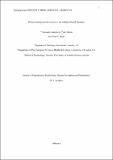Process timing and its relation to the coding of tonal harmony.

View/
Date
2010Author
Elliott, Mark
Metadata
Show full item recordUsage
This item's downloads: 599 (view details)
Recommended Citation
Aksentijevic, A., Barber, P. J., & Elliott, M. A. (2010). Process timing and its relation to the coding of tonal harmony. Journal of Experimental Psychology: Human Perception and Performance (In press).
Abstract
Advances in auditory research suggest that gamma-band synchronization of frequency-specific cortical loci could be responsible for the integration of pure tones (harmonics) into harmonic complex tones. Thus far, evidence for such a mechanism has been revealed in neurophysiological studies, with little corroborative psychophysical evidence. In 6 experiments, we observed a rate- and time- specific response-time advantage for a sequence of target pips when the defining frequency of the target was a fractional multiple of a priming frequency. The effect was only observed when the prime and target tone-pip sequences were presented at 33 pips per second (pps) and when the inter-stimulus interval was approximately 100 and 250 milliseconds (ms). This evidence implicates oscillatory gamma-band activity in the representation of harmonic complex tones and suggests that synchronization with precise temporal characteristics is important for disambiguating related harmonic templates. An outline of a model is presented, which accounts for these findings in terms of fast resynchronization of relevant neuronal assemblies.

